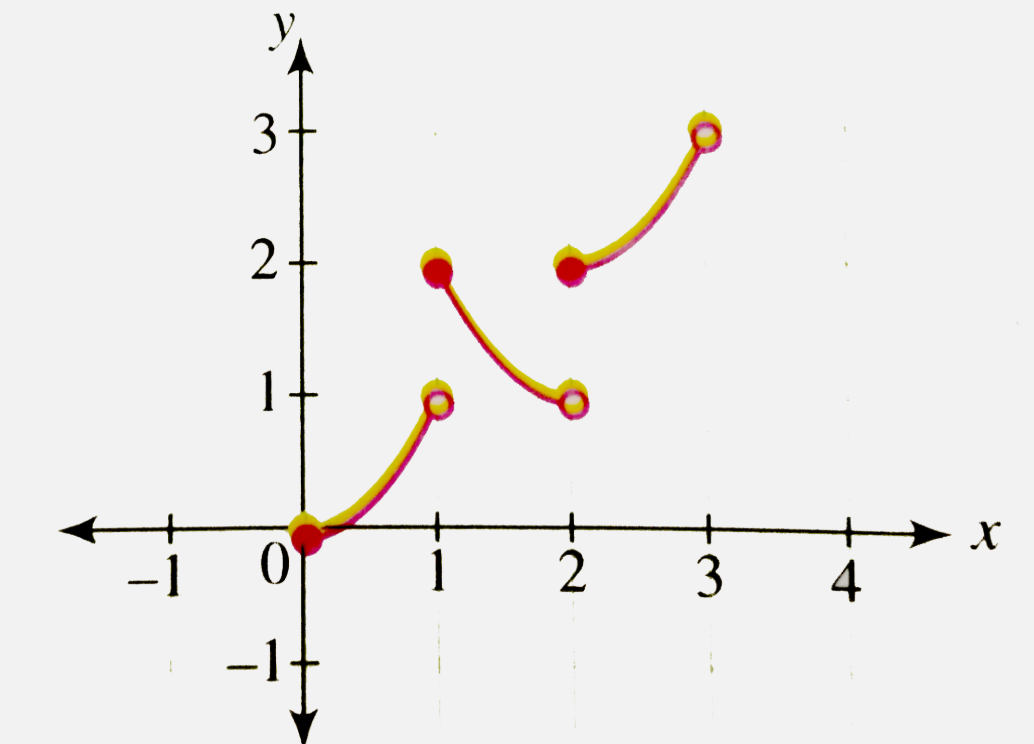Let f(x)=x2−2x−1∀x∈R Let f:(−∞,a]→[b,∞), where a is the largest real number for which f(x) is bijective. If f:R→R , g(x)=f(x)+3x−1 , then the least value of function y=g(|x|) is Solution in Tamil
(−2,−1)
(−2,0)
(−1,0)
(0,1)
The correct Answer is:A
f(x)=(x−1)2−2
⇒ a=1,b=−2
Now, g(x)=x2+x−2=(x+12)2−94
⇒ g(|x|)=(|x|+12)2−94
∴ gmin=g(0)=−2
Now, f:[1,∞)→[−2,∞),
⇒ f−1:[−2,∞)→[1,∞),
f(x)=y
⇒ x2−2x−(1+y)=0
⇒ x=2π√4+4(1+y)2
⇒ x=1±√2+y
So, f−1(y)=1+√2+y,
f−1(x)=1+√2+x
Graph of y=f(|x|)

From graph f(|x|)=k has four roots if k∈(−2,−1).
Topper's Solved these Questions
- FUNCTIONSBOOK - CENGAGECHAPTER - FUNCTIONSEXERCISE - Question Bank
21 Videos
- FUNCTIONSBOOK - CENGAGECHAPTER - FUNCTIONSEXERCISE - Multiple Correct Answers Type
10 Videos
- EQUATION OF PLANE AND ITS APPLICATIONS -IIBOOK - CENGAGECHAPTER - EQUATION OF PLANE AND ITS APPLICATIONS -IIEXERCISE - DPP 3.4
18 Videos
- GETTING STARTED WITH GRAPHSBOOK - CENGAGECHAPTER - GETTING STARTED WITH GRAPHSEXERCISE - Exercise
18 Videos
Similar Questions
If there are four distinct real numbers satisfying thẻ equation ∣∣x2−4x−7∣∣=n, then number of integers in the range of n is
View SolutionThe function f(x)=cos−1⎛⎝2[|sinx|+|cosx|]sin2x+2sinx+114⎞⎠ is defined if x belongs to (where [.] represents the greatest integer function)
View SolutionLet A(0,6,6), B(6,6,0) and C(6,0,6) are three points and point D is moving on the line x+z−3=0=y. If G is centroid of ΔABC, then minimum value of GD is
View SolutionDoes the following graph pass the vertical or horizontal line test ?

View SolutionLet f(x)=x^(2)-2x-1AA xi nR Let f:(-oo,a]rarr[b,oo), where a is the largest real number for which f(x) is bijective.If f:R rarr R,g(x)=f(x)+3x-1, then the least value of function y=g(|x|) is
View SolutionLet f'(x)>0AA x in R and g(x)=f(2-x)+f(4+x) Then g(x) is increasing in (i)(-oo,-1)( ii) (-oo,0)( iii) (-1,oo)( iv ) none of these
View SolutionLet a real valued function f satisfy f(x+y)=f(x)f(y)∀x,y∈Randf(0)≠0 Then g(x)=f(x)1+[f(x)]2 is
View SolutionLet f(x)=x2−2x−1∀x∈R,Letf,(−∞,a]→[b,∞), where 'a' is the largest real number for which f(x) is bijective.
The value of (a+b) is equal to
View SolutionLet f:R→R be a continous and differentiable function such that f(x+y)=f(x).F(y)∀x,y,f(x)≠0andf(0)=1andf'(0)=2.
Let f(xy)=g(x).G(y)∀x,yandg'(1)=2.g(1)≠=0
The number of values of x, where f(x)g(x):
View SolutionLet f(x) be a twice differentiable function in (−∞,∞) such that f''(x)<0∀x∈R, g(x)=f(x)+f(1-x) and g'((1)/(4))=0 then
View SolutionLet the function f:R→R be defined byf(x)=x3−x2+(x−1)sinxandletg:R→R be an arbitrary function Let fg:R→R be the function defined by (fg)(x)=f(x)g(x). Then which of the folloiwng statements is/are TRUE ?
View SolutionLet f:R→R be a real function. The function f is double differentiable. If there exists n∈N and p∈R such that limx→∞xnf(x)=p and there exists limx→∞xn+1f(x) , then limx→∞xn+1f'(x) is equal to
View SolutionLet f:(0,∞)→R be a differentiable function such that f'(x)=2−f(x)x for all x∈(0,∞) and f(1)=1, then
View SolutionLet f(x)=x2−2x−1∀ξnR Let f:(−∞,a]→[b,∞), where a is the largest real number for which f(x) is bijective. If f:R→R , g(x)=f(x)+3x−1 , then the least value of function y=g(|x|) is
View SolutionLet f:R→R be a positive increasing function with Ltx→∞f(3x)f(x)=1 then Ltx→∞f(2x)f(x)=
View SolutionLet R be the set of real numbers and the functionsf:R→R and g:R→R be defined f(x)=x2+2x−3 and g(x)=x+1. Then the value of x for which f(g(x))=g(f(x)) is
View Solution
